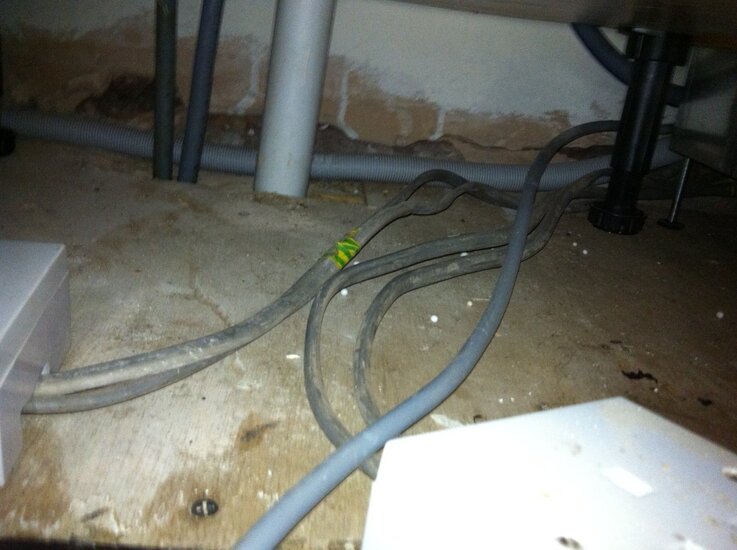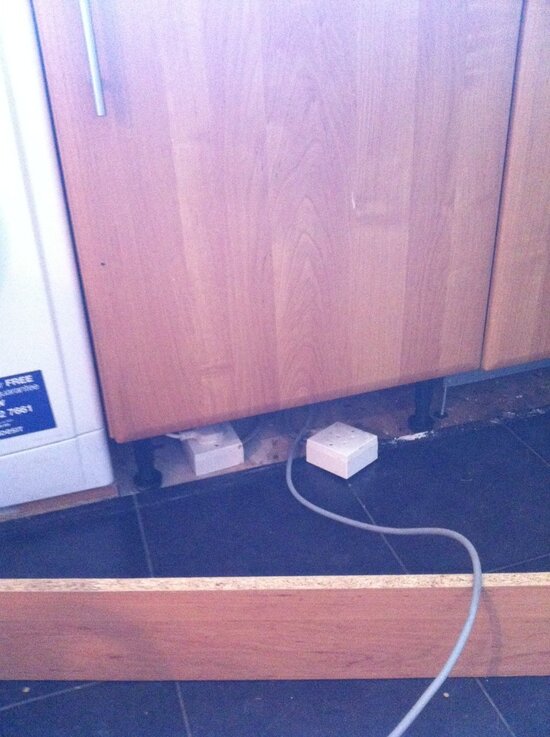R
rsmck
Firstly, I'm not an electrician - I've also not been on the forum for a while but I did receive a lot of helpful advice whilst rewiring my own home earlier in the year (and yes, it's now complete - my slightly esoteric lighting control system excluded  )
)
Anyway, my neighbour (who has no electrical knowledge beyond trying to switch the RCD back on about 10 times before giving up) had a bit of an electrical problem recently (main RCD kept tripping) in the middle of the night and asked me to have a look at it. Not being an electrician I wasn't willing to carry out any remedial work but I figured if I could at least determine the fault and get him some power that'd be a start.
After resetting the RCD and energising each circuit in turn the fault was with the kitchen ring (helpfully unlabeled) and I found that the washing machine and dishwasher had both been installed connected to two sockets in surface pattress boxes on 2.5mm t&e underneath the sink (which had clearly been exposed to water) - despite this the sockets weren't the problem, the dishwasher itself was causing the trip and simply unplugging it means they can at least use the rest of their house. I suggested he replace the dishwasher and call an electrician to look at the sockets.
It has got me thinking though, is there an acceptable way to use trailing sockets (preferably proper duraplug ones) perhaps on a H07 flex wired to the FCU to supply appliances such as these ? The idea, whilst badly implemented, actually makes sense as it's much easier to access the socket than if it were on the wall behind the appliance.
Again I am not an electrician and have advised him to call one... just was curious if anyone had seen this before and what they'd recommend if they encountered it.


 )
)Anyway, my neighbour (who has no electrical knowledge beyond trying to switch the RCD back on about 10 times before giving up) had a bit of an electrical problem recently (main RCD kept tripping) in the middle of the night and asked me to have a look at it. Not being an electrician I wasn't willing to carry out any remedial work but I figured if I could at least determine the fault and get him some power that'd be a start.
After resetting the RCD and energising each circuit in turn the fault was with the kitchen ring (helpfully unlabeled) and I found that the washing machine and dishwasher had both been installed connected to two sockets in surface pattress boxes on 2.5mm t&e underneath the sink (which had clearly been exposed to water) - despite this the sockets weren't the problem, the dishwasher itself was causing the trip and simply unplugging it means they can at least use the rest of their house. I suggested he replace the dishwasher and call an electrician to look at the sockets.
It has got me thinking though, is there an acceptable way to use trailing sockets (preferably proper duraplug ones) perhaps on a H07 flex wired to the FCU to supply appliances such as these ? The idea, whilst badly implemented, actually makes sense as it's much easier to access the socket than if it were on the wall behind the appliance.
Again I am not an electrician and have advised him to call one... just was curious if anyone had seen this before and what they'd recommend if they encountered it.











